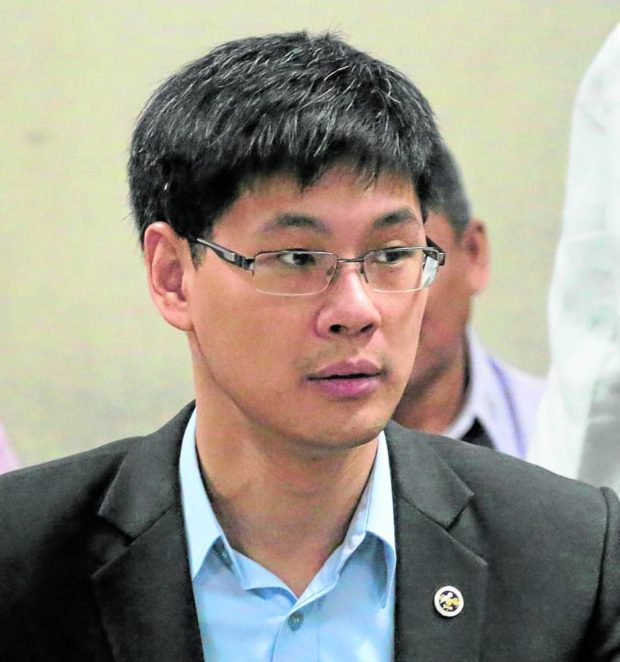
Karl Kendrick Chua. FILE PHOTO
The government should revise how it monitors COVID-19 cases by highlighting only severe infections and measuring deaths as a share of the population so that more Filipinos won’t be scared to go out, according to the country’s chief economist.
Speaking to Asian Institute of Management (AIM) alumni on Wednesday night, Socioeconomic Planning Secretary Karl Kendrick Chua pitched a 10-point policy designed to accelerate and sustain economic recovery despite new variants like Omicron cropping up.
“The reality today is that the virus is not going to go away easily. And we will have to live with it for a longer period of time, similar to, maybe, the flu. And to live with this, we have to change our metrics, focus on vaccination, and focus on minimizing the severe and critical cases and also deaths,” Chua said.
Chua, who heads the state planning agency National Economic and Development Authority (Neda), said the key to living with COVID-19 was to consider it as “endemic” or common, similar to what Singapore and Portugal did.
“The UK and USA have made pronouncements about the virus not going to go away; Thailand and South Korea have focused on living with the virus, so if we proceed with this idea of making the paradigm about less of the pandemic and more of the endemic part, then we are not alone,” he pointed out.
Chua noted that countries which considered COVID-19 as endemic already made strides in returning mobility and public transport, as well as reopening schools and economic sectors like travel and tourism.
“This is the direction that the Philippines should proceed with haste if we want to recover faster,” he said.
Metrics
Included in Chua’s proposed 10-point policy is changing the metrics being used by the government whenever it makes a decision in responding to the health challenges posed by COVID-19.
At present, decisions are based on the cumulative number of cases, total deaths, as well as the overall vaccination rate.
Chua proposed limiting monitoring to total severe or critical cases who were hospitalized due to COVID-19, the case fatality ratio or the share of deaths to the number of infections, and the vaccination rate.
“The benefit of moving to this metric is to reduce the need to raise the alert levels [which] scare the people when cases go up. It will facilitate a shift in the mindset of the people to live with the virus,” Chua said.
“If there are 20,000 cases but if 95 percent are mild, then we may be reacting too much,” he added.
The metrics would also emphasize the positives of getting vaccinated, especially among those who have yet to get their jabs, he said. Global research had shown that vaccines minimized deaths among those infected by COVID-19.
Chua also proposed to ramp up mass vaccination to a bigger chunk of the population, including children.
“Many countries are already moving to vaccinate younger children, so there is, I think, no reason why the Philippines should not follow suit the moment the approvals are granted, and, in some cases, the moment the suppliers have applied for an emergency use authorization,” he said.
Adequate health care
Chua’s presentation noted that from record-high levels of more than 26,000 new daily infections in mid-September, cases fell to less than 1,000 a day by mid-November after the vaccination program was accelerated.
The third leg of Chua’s 10-point policy proposal is to ensure adequate health-care capacity at all times. “If we are moving to this endemic mindset of prioritizing or focusing only on the critical and severe [cases], then the idea here is to improve our health-care capacity.”
Chua also called for the reopening of more productive sectors and expanding public transport capacity by maintaining the current targeted and localized alert level system.
Chua also pushed to reopen face-to-face classes, subject to minimum health standards; remove most local-level restrictions so that vaccinated local tourists could travel across the archipelago; further relax requirements for returning overseas Filipinos as well as foreigners visiting the country; accelerate digitalization; build societal resilience against any future pandemic, and enact a pandemic flexibility bill.
Context
Chua said the proposed pandemic budget and flexibility bill would be similar and yet complement and fill the gaps of the National Disaster Risk Reduction and Management Council law, which he said “does not provide enough funds, specifically for national public health emergencies.”
Meanwhile, Health Undersecretary Maria Rosario Vergeire on Thursday underscored the importance of considering each country’s context when comparing how they respond to the COVID-19 pandemic.
“I would always say that we cannot compare apples to oranges… we have to look at the country’s specific context when we do these surveys,” she said in a television interview.
Resilience score
Vergeire was reacting to Bloomberg’s COVID-19 Resilience Ranking for November, which placed the Philippines in the last spot as the “worst place to be during the pandemic” for the third month in a row.
With a resilience score of 43.1, the country did not move from its 53rd spot in October when it had a resilience score of 40.5. In September, the Philippines was also in the same rank with a resilience score of 40.2.
Vergeire stressed that every country has a specific situation, health system and resources.
“[N]ot all countries are comparable in terms of resources…so comparing all these countries across with these different capacities, different situations, different initial situation at the start of the pandemic would just not be acceptable. I think the analysis would just be biased because of that,” she said.
But nevertheless, Vergeire said that such survey or study “will always help us to improve our response better, to improve on what we do, and to get some points for us to do better.” —With a report from Tina G. Santos